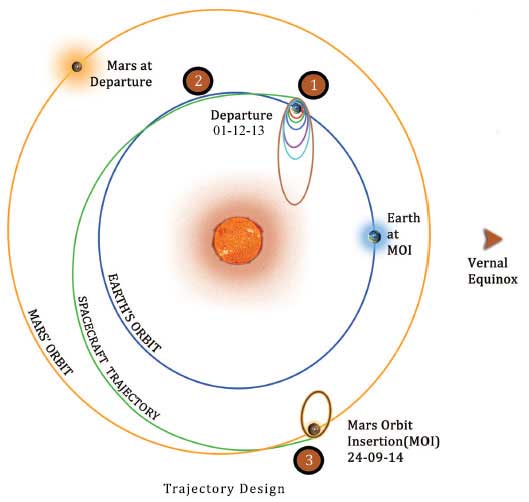The researchers have studied the turbulence in Sun’s corona using radio signals sent to Earth by the ultra-low-cost Mars orbiter when the Earth and Mars were in conjunction on the opposite sides of the Sun (the conjunction usually happens once in approximately two years). The radio signals from the orbiter had passed through the corona region of Sun at a close distance of 10 Rʘ (1 Rʘ = solar radii = 696,340 km). The frequency residual of the received signal was analyzed to obtain coronal turbulence spectrum. The findings seemed to be consistent with in-situ findings of Parker Solar Probe. The Mars Orbiter Mission (MOM) provided a very low-cost opportunity to study dynamics in coronal region (in absence of a very high cost in-situ solar probe) and a new insight into how investigation of turbulence in solar coronal region using radio signals sent by a Mars orbiter to Earth can help improve prediction of solar activity which is of great significance for life forms and the civilization on Earth.
The Mars Orbiter Mission (MOM) of Indian Space Research Organization (ISRO) was launched on 5 November 2013 with a planned mission lifetime of 6 months. It has far surpassed its lifetime and is currently in the extended mission phase.
A team of researchers used radio signals from the orbiter to study the solar corona when the Earth and Mars were on opposite sides of the Sun. During the periods of conjunction, which usually happen once in approximately two years, radio signals from the orbiter cross through the solar coronal region as close as 10 Rʘ (1 Rʘ = solar radii = 696,340 km) helio-altitude from the center of Sun and gives opportunities to study solar dynamics.
The solar corona is the region where temperature can be as high as several million degrees centigrade. The solar winds originate and accelerate in this region and engulf interplanetary spaces which shape the magnetosphere of planets and affect the space weather near-Earth environment. Studying this is an important imperative1. Having an in-situ probe would be an ideal however use of radio signals (transmitted by spacecraft and received at Earth after traveling through the coronal region provide an excellent alternative.
In the recent paper2 published in the Monthly Notices of Royal Astronomical Society, the researchers studied the turbulence in the solar coronal region during a period of declining phase of solar cycle and report that solar winds accelerates and its transition from subalfvenic to super-alfvenic flow occurs around 10–15 Rʘ. They achieve saturation at a comparatively lower helio-altitudes compared to high solar activity period. Incidentally, this finding seems to be supported by the direct observation of Solar Corona by Parker Probe3 as well.
As the solar corona is a charged plasma medium and has intrinsic turbulence, it introduces dispersive effects in parameters of electromagnetic radio waves traveling through it. Turbulence in the coronal medium produces fluctuations in plasma density which get registered as fluctuations in the phase of radio waves emerging through that medium. Thus, radio signals received at the ground station contain the signature of propagating medium and are spectrally analyzed to derive turbulence spectrum in the medium. This forms the basis of the coronal radio-sounding technique which has been used by the spacecraft to study coronal regions.
Doppler frequency residuals obtained from signals are spectrally analyzed to obtain coronal turbulence spectrum at heliocentric distances ranging between 4 and 20 Rʘ. This is the region where solar wind primarily gets accelerated. The changes in turbulence regime are well reflected in spectral index values of the temporal frequency fluctuation spectrum. It is observed that turbulence power spectrum (temporal spectrum of frequency fluctuations) at a lower heliocentric distance (<10 Rʘ), has flattened at lower frequencies regions with lower spectral index which corresponds to solar wind acceleration region. Lower spectral index values closer to the Sun’s surface denotes the energy input regime where turbulence is still underdeveloped. For larger heliocentric distances (> 10Rʘ), the curve steepens with spectral index close to 2/3, that is indicative of inertial regimes of developed Kolmogorov-type turbulence where energy is transported through cascading.
The overall features of the turbulence spectrum depend upon factors such as the phase of the solar activity cycle, the relative prevalence of solar active regions, and coronal holes. This work based on MOM data reports an insight into the feeble maxima of solar cycle 24, which is recorded as a peculiar solar cycle in terms of overall lower activity than other previous cycles.
Interestingly, this study demonstrates a very low-cost way to investigate and monitor turbulence in the solar coronal region by using radio sounding method. This can be immensely helpful in keeping a tab on solar activity which in turn can be crucial in predicting all important solar weather particularly in the vicinity of Earth.
***
DOI: https://doi.org/10.29198/scieu/2201151
***
References:
- Prasad U., 2021. Space Weather, Solar Wind Disturbances and Radio Bursts. Scientific European. Published 11 February 2021. Available at https://www.scientificeuropean.co.uk/sciences/space/space-weather-solar-wind-disturbances-and-radio-bursts/
- Jain R., et al 2022. A study on the solar coronal dynamics during the post-maxima phase of the solar cycle 24 using S-band radio signals from the Indian Mars orbiter mission. Monthly Notices of the Royal Astronomical Society, stac056. Received in original form 26 September 2021. Published 13 January 2022. DOI: https://doi.org/10.1093/mnras/stac056
- J. C. Kasper et al. Parker Solar Probe Enters the Magnetically Dominated Solar Corona. Phys. Rev. Lett. 127, 255101. Received 31 October 2021. Published 14 December 2021. DOI: https://doi.org/10.1103/PhysRevLett.127.255101
***




































